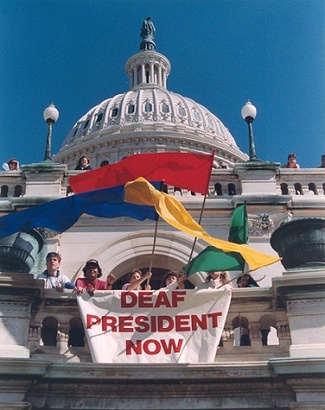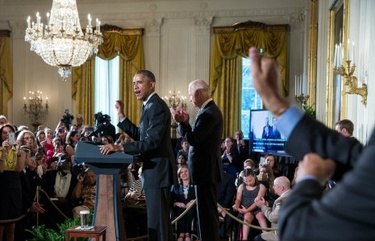ADA Then & Now: Where We Have Been & Where We Go From Here
Posted by: Staff Writer on July 21, 2015

This week we are watching as the nation celebrates the 25th Anniversary of the signing of Americans with Disabilities Act (ADA) into law by then President George H.W. Bush. Current President Obama said, “Thanks to the ADA, the places that comprise our shared American life- schools, workplaces, movie theaters, courthouses, buses, baseball stadiums, national parks- they truly belong to everyone.”
Indeed, one of the greatest successes of ADA is the increase in access and physical accommodations for those with physical disabilities, such as ramps and revised building codes.
The Deaf community has been long involved in the passage of ADA and its modern day realities. We will explore both then and now as we acknowledge its key successes and grapple with some of the problems that remain for Deaf people.
The Road to ADA
Lets go back and revisit some key moments. The passage of the Rehabilitation Act, Section 504 in 1973 outlined the responsibilities of the government and those receiving federal funding to provide accessible accommodations for those with disabilities. Disability rights groups saw this as a pivotal milestone, one that forced the government to begin to pay attention to the needs of Americans with disabilities. But it was not enough. Soon after the passage, individual activists and groups began to fight for a more wide-sweeping law, one that would go beyond the reaches of the federal government and the public sector and into the private sector and everyday realities of Americans with disabilities. During the National Council on Disabilities in 1986, they submitted a report to President Reagan and Congress, “Toward Independence: An Assessment of Federal Laws and Programs Affecting Persons with Disabilities- With Legislative Recommendations.” It was this report that marked the beginnings of the creation of the ADA. The report encouraged both the President and Congress to think more seriously about creating a new, stronger law.
During the National Council on Disabilities in 1986, they submitted a report to President Reagan and Congress, “Toward Independence: An Assessment of Federal Laws and Programs Affecting Persons with Disabilities- With Legislative Recommendations.” It was this report that marked the beginnings of the creation of the ADA. The report encouraged both the President and Congress to think more seriously about creating a new, stronger law.
But change and movements are not won solely through the work of government officials and the legislative branch; time and again, all throughout American history, we witness that real changes also must take place in the public arena. Two movements in particular made the rest of the American public aware of the plight of Americans with disabilities and the need for improved laws that would safeguard and protect their rights, including the right to access and accommodations.
One movement that galvanized support and captured the attention of the national media included the work of ADAPT, Americans Disabled for Accessible Public Transportation. ADAPT, a grassroots movement and group well known for nonviolent direct action, began in the 1970’s in Denver, CO and continued throughout the 1980’s, growing nationwide to protest the lack of access on public transportation, buses in particular in major cities. Through the use of lawsuits and maintaining ongoing, coordinated, and intense pressure through the use of nonviolent direct action on city transits all over the country, they were instrumental in changing the attitudes of Americans without disabilities to recognize and support the need for improved transportation access for people with disabilities, particularly wheelchair users.
Deaf President Now (DPN), in 1988, was another critical movement that helped push ADA through Congress. The students, faculty and alumni of Gallaudet University successful fought together to secure a Deaf president to replace over 100 years of hearing presidents. The timing of DPN and the extent the national and international media picked up the story meant that not only were disAbility rights front and center, the specific rights of Deaf people, fighting for accurate representation and self-determination were brought to the attention on a scale that had never before been achieved; hearing people all over the world were paying attention to the struggles of the Deaf community.
ADA Becomes the Law of the Land
 When President George H.W. Bush signed the American Disabilities Act into law on July 26, 1990 it was the culmination of nearly two decades of work. It was later amended in 2008. It addressed multiple aspects and provided broad coverage, outlined by four different Titles. Title I addressed employers and charged them with providing access and accommodations at all stages of employment, including the interview process. Title II outlined the specific responsibilities of all government entities at every level as well as those receiving federal funding. Title III made clear the expectation and legal requirements of places of public accommodations and the private sector and those businesses open to the public, including theaters, private schools, for profit and not for profit businesses. Title IV spelled out the responsibilities of the government to establish and maintain accessible phone communications which resulted in the implementation of a 24/hour federal relay system and accessible phone equipment, overseen by the federal government.
When President George H.W. Bush signed the American Disabilities Act into law on July 26, 1990 it was the culmination of nearly two decades of work. It was later amended in 2008. It addressed multiple aspects and provided broad coverage, outlined by four different Titles. Title I addressed employers and charged them with providing access and accommodations at all stages of employment, including the interview process. Title II outlined the specific responsibilities of all government entities at every level as well as those receiving federal funding. Title III made clear the expectation and legal requirements of places of public accommodations and the private sector and those businesses open to the public, including theaters, private schools, for profit and not for profit businesses. Title IV spelled out the responsibilities of the government to establish and maintain accessible phone communications which resulted in the implementation of a 24/hour federal relay system and accessible phone equipment, overseen by the federal government.
ADA Accomplishments and Victories
One of the most noticeable and noteworthy accomplishments of ADA is the improvement in access in public spaces for those with physical disabilities, in particular for wheelchair users. The addition of ramps, revised building codes, accessible wheelchair lifts on public transportation has made a tremendous difference.
Michael Richardson is the Director for NW ADA Center, at the University of Washington and funded by the National Institute on Disability, Independent Living, and Rehabilitation Research (NIDILRR). One of ten national centers, covering Region 10 and overseeing Alaska, Idaho, Oregon and Washington state, Richardson deals every day with the achievements, realities, and limitations of the ADA.
When asked to discuss the achievements of ADA for the Deaf community, he points to the the 2008 Amendment which helped to clarify the role of interpreters, specifying in more clear terms what is a qualified interpreter, and to emphasize the need for impartial interpreters, barring the practice of using children and family members as interpreters.
In general, access for hard of hearing individuals and those with a hearing loss using English-based accommodations have seen many more gains in access, accommodation and effective communication. Improved access such as captioning on television, in theaters and online streaming movies and video rentals have benefited from ADA. The successful increase in of the use of CART (Communication Access Realtime Translation) further provides access for those who need English-based accommodations for effective communication.
Gains for those that need non-English, ASL-based accommodations have lagged noticeably behind.
ADA Challenges and Concerns
ADA still has not significantly closed the unemployment gap between Americans without disabilities and Americans with disabilities, with those with disabilities facing up to an 83% unemployment rate according to the US Department of Labor, despite being able and willing to work, attributed to attitude barriers and pervasive, inaccurate stereotypes.
 ADA still has not effectively created change in the medical setting, especially for those with non-English based access and accommodation needs for effective communication, such as the need for ASL interpreters.
ADA still has not effectively created change in the medical setting, especially for those with non-English based access and accommodation needs for effective communication, such as the need for ASL interpreters.
ADA still has not addressed the additional problematic use of Video Remote Interpreters in medical settings. Richardson points out, “When the internet breaks down, when there are many people in the room, when a patient is coming out of anesthesia or under the influence of medication, when in pain, viewing an interpreter on a screen does not work.” Hospitals continue to be woefully untrained to understand the difference between situations that call for using a VRI and situations that require the use of a live, in person interpreter to secure effective communication.
Richardson estimates that approximately 95% of the court cases highlighted by Barrier-Free Healthcare Initiative are related to access to health care cases are about Deaf access to auxiliary aids and services.
ADA- Where do We Go From Here
Richardson knows there is more to do, and the burden still falls on individuals. He encourages, “I want to see more Deaf community members becoming more familiar with ADA and better experts… to advocate for themselves, file complaints, follow up, to fight, and be empowered.” His work centers heavily around advocacy, outreach, and education- training both businesses, governments, and individuals. He emphasizes the need for more Deaf people on the front lines, doing the work to improve access for Deaf people.
It is clear that change at the legislative level, through the passage of laws nets only limited changes. Education, training and working to increase awareness of what the laws mean and how businesses and entities covered under Titles I-IV are required to carry out the law are still needed. Additionally, changing the hearts and minds of the public, challenging stereotypes, changing attitudes will be the ongoing work of both the Deaf community and the disAbility community and their allies. For the real barriers that remain are not one of disability but of attitude.
Individuals cannot do it alone, but laws themselves can only be tested one situation at a time. The real hallmark of change then is not from the signing of a law, but the ongoing work of individuals, in the system and outside the system, fighting each day for their basic rights, for access, for the recognition that they are human beings, that they are valuable contributors to society, and they are recognized worthy of equal protections. It is then, that the need for allies, becomes paramount if the struggle is to continue.
The Power of Social Media
 While the rest of the nation takes a moment to celebrate how far we have come, even President Obama acknowledges there is more work to do. “Now, days like today are a celebration of our history. But they’re also a chance to rededicate ourselves to the future — to address the injustices that still linger, to remove the barriers that remain,” Obama said. “We all know too many people with disabilities are still unemployed — even though they can work, even though they want to work, even though they have so much to contribute.”
While the rest of the nation takes a moment to celebrate how far we have come, even President Obama acknowledges there is more work to do. “Now, days like today are a celebration of our history. But they’re also a chance to rededicate ourselves to the future — to address the injustices that still linger, to remove the barriers that remain,” Obama said. “We all know too many people with disabilities are still unemployed — even though they can work, even though they want to work, even though they have so much to contribute.”
The power of social media is coming to the forefront as a potential vehicle for change for Deaf people who wish to bring to the public the plight of ongoing communication barriers. This year we have seen multiple stories go viral on social media channels such as Facebook and Twitter, highlighting the high stakes, life-threatening realities of hospitals not providing effective communicaiton for Deaf patients such as the case in Tenessee and Colorado that we covered here in this article published by deaffriendly.com Enough is Enough: Deaf Demand Access in Medical Settings. Just this week, Margaret Weiss, a Deaf woman in Florida struggled through 12 hours of labor without an interpreter when the Video Remote Interpreter failed to work. She’s not alone. Deaf people and their struggles to gain access are commonplace. One thing is clear, harnessing the ability of social media to go viral and spread awareness is becoming a powerful agent for change.
Beyond the ADA
A three pronged approach, coordinated and working in synchronicity is needed. The first prong, strengthening existing laws and continuing to implement the necessary changes at the institutional level needs to happen. The second prong, we need more boots on the ground work, more bodies on the front lines; we need those directly impacted by the reality of discrimination against Deaf people to get involved and fight. We need to be working together with allies to change the system from both inside and outside, in solidarity with one another. But we cannot do this without the last prong, the most important piece, making sure the media and Americans without disabilities understands that yes, while we do celebrate the achievements of ADA, we know it is not enough. ADA was only the beginning. More must be done. We must work together to push for greater access and more awareness to create a more #deaffriendly world for Deaf people in America.
Tags
- ada
- anniversary
- americans
- disabilities
- act
- americans with disabilities act
- signing
- asl
- obama
- bush
- accessible
- deaf
- schools
- workplaces
- movie theaters
- courthouses
- buses
- baseball stadiums
- national parks




Comments